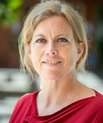“We need to internationalise research communication”
Almost 50,000 readers, translation into French and publication in the French daily newspaper Le Monde as well as an invitation to be keynote speaker at an international conference in the USA with all expenses paid. Does it sound almost too good to be true? It is the result of one research communication article written by Hanne K. Adriansen, associate professor and international coordinator at the Danish School of Education.
Hanne K. Adriansen holds a PhD in human geography and is employed as an associate professor at the Danish School of Education. For the past 15 years, she has pursued various research interests, but a recurring theme has been mobility – physical and social mobility as well as the mobility of humans, animals and ideas. She is interested in how internationalisation and international educational collaboration create “the world in new ways”. And, curiously enough, a relatively new acquaintance has made a world of difference in relation to media coverage of her own research. The media platform in question is the research communication site The Conversation, which has gained significant ground in recent years.
-It was a bit of a coincidence that I learned about The Conversation. In connection with an international conference, I started talking to a journalist from The Conversation, Natasha Joseph, who had heard my presentation. She thought that it was a really exciting topic and asked me to send my paper. That actually led to my first article being published. The article Global academic collaboration: a new form of colonisation? very quickly had a large number of readers, and I was asked whether it could be translated into French. Until now, almost 60,000 people have read the article. It’s been fascinating to see how the articles circulate among groups of people that my research would normally not reach – the Kenyan author Binyavanga Wainaina linked to it, the French embassy in South Africa sent out links, and I was invited to be a keynote speaker at a conference on global health in New York, says Hanne K. Adriansen enthusiastically.
It’s been fascinating to see how the articles circulate among groups of people that my research would normally not reach – the Kenyan author Binyavanga Wainaina linked to it, the French embassy in South Africa sent out links, and I was invited to be a keynote speaker at a conference on global health in New York, says Hanne K. Adriansen
Interview on South African television
Two additional articles have subsequently been published – The power and politics of knowledge: what African universities need to do and Khanya College: a South African story of decolonisation. The first article resulted in an interview on South African television, and the second one, which was published a month ago, sparked a lively debate in the comments section and has already been read by more than 20,000 people. So the message from Hanne K. Adriansen based on her own experience is clear: If you as a researcher want your research to attract a bigger audience, also internationally, The Conversation is a very efficient platform, where you can communicate your results or insight yourself.
The way to publicity for Hanne K. Adriansen was a bit different than it usually is, says Natasha Joseph, who is a journalist at The Conversation. She explains how to become a writer at The Conversation Africa, but it is the same procedure in all of their sections around the world.
- Normally you first sign up as a writer on our website. You must be employed as a researcher or academic with a university or research institution. PhD candidates under supervision by an academic can write for us, but we don’t currently publish articles from Master’s students. When you have signed up, you can pitch an article idea on our website. We only allow authors to write on a subject on which they have proven expertise, which they must disclose alongside their article.
What is the procedure from pitch to article?
- To pitch an article, you can visit theconversation.com – on the right-hand side about halfway down you'll see a button that reads “Pitch an idea”. You can send pitches through that. It is best if you sign up as an author – this gives you a profile on our site, and it also means that when you write an article, you and an editor are able to work in our very user-friendly system simultaneously. To sign up, you can go to theconversation.com and look for the button on the top right-hand side that reads “Become an author”, says Natasha Joseph.
If you had to pitch The Conversation to researchers from the Faculty of Arts, what would you say are the benefits?
- The value of The Conversation is that we offer two things: a dedicated editing service, and a Creative Commons licence which means your article, once it’s appeared on our site, can be republished anywhere in the world. In this way, your important work is not only contained in academic journals or presented at conferences, but is shared with a global audience of non-academics. In this age of science communication, with more academics and universities embracing the idea of public engagement, it’s a really valuable platform. Our editors are all experienced journalists whose job it is to work with you to ensure that your work is clearly and simply communicated without losing its academic rigour. We also link to journal articles, which means that you can generate some traffic to your original journal work, says Natasha Joseph, who works at The Conversation Africa, but the same options are found on websites in Australia, England, USA, France and Canada, says Natasha Joseph.
Social media as a distribution channel
Back in Denmark, Hanne K. Adriansen would like to share her positive international research communication experience:
- In academic circles, we often discuss the importance of publishing in international journals, but it’s equally important to communicate your research internationally and not only focus on publicity in a Danish context. It definitely opens some doors and considerably expands your professional network, and the number of people who benefit from your research will increase significantly.
In this connection, Hanne K. Adriansen emphasises the importance of using the social media to communicate your research.
- Most of us are offered all kinds of new ways of communicating, and it can be difficult to know what is worth spending time on. After having published a book with Routledge, the publishing company asked us to write author profiles, write a blog or contribute to a Q&A on Routledge’s website. We said yes to everything, but what really made a difference was tweeting about the book – I only had around 150 followers on Twitter, so I never dreamed that it could lead to anything. But some of my followers have a lot of followers, so three retweets later, my small book advertisement had reached 11,000 Twitter users. One of them was employed with Times Higher Education and was going to organise a so-called Africa Summit with a view to discussing the future of African universities. I was invited to be a keynote at their summit in Ghana, because she had seen a link to my book on Twitter! And it was in Ghana that I met Natasha from The Conversation.
Facts about The Conversation
The Conversation started in Melbourne. They have an international network of editors from dedicated sites in Australia, the UK, US, Africa, France and Canada. They believe in open access and the free flow of information. The Conversation is a free resource: free to read and free to share or republish under Creative Commons. All you need to do is follow our simple guidelines. They have also become an indispensable media resource: providing free content, ideas and talent to follow up for press, web, radio or TV.
Share your experience
Are you a researcher at #artsaudk – and do you also have experience with publishing in The Conversation? Please share it with #conversationatarts

